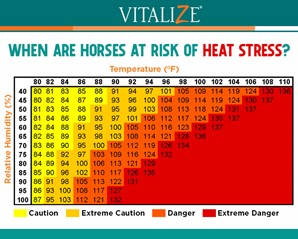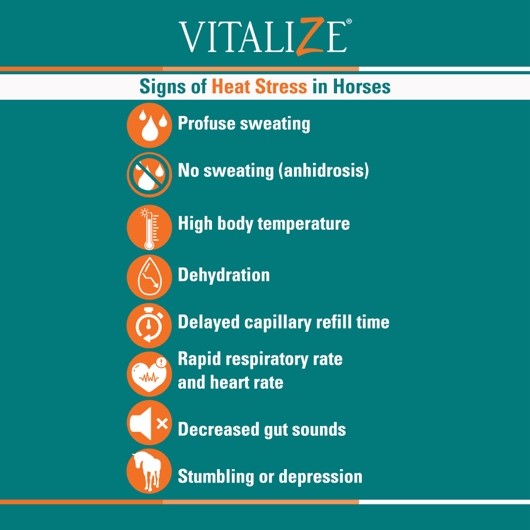Horses have a natural ability to handle extreme temperatures much more effectively than humans. This is important to remember; however, it is also important to consider the upper and lower limits of their comfort zone. Also known as the thermoneutral zone, a horse’s “comfort zone” is generally between 40- and 80-degrees Fahrenheit. Inside of these temperatures, horses can maintain a normal body temperature without expending excess energy for heat dissipation or generation. Higher than the 80-degree mark, horses will likely encounter heat stress.

No matter if you live in the northeast or southwest, your horse may exceed the upper limits of his or her comfort zone frequently in the summertime and experience heat stress. When the temperature rises, horses must initiate physiological processes to cool itself, and these are often the first signs of heat stress. A horse dissipates body heat by:
- Sweating (evaporative cooling)
-
Rapid breathing/respiration (evaporative cooling)
-
Vasodilation/maximizing blood flow to skin’s surface (convective cooling)

The first sign of heat stress may be something as simple as poor performance or lethargy, followed by dehydration, high body temperature, or even decreased gut sounds. As the temperatures continue to rise, heat stress can become much more serious and, if left unchecked, potentially fatal.
Don’t let heat stress have a negative impact on your horse. BioZyme® Inc. has just introduced Vitalize® Blazin’, the most innovative product available to help manage the effects of heat stress in horses.
Vitalize Blazin’ is an oral liquid product to support normal recovery from heat stress and exertion in horses, beginning at the cellular level. It contains a proprietary blend of L-arginine, L-citrulline, and Aspergillus oryzae to support blood flow and cooling. In addition, it promotes water retention and contains antioxidants to mitigate damaging free radicals that are caused by exertion and exposure to heat.
“As the temperature rises, horses may begin to experience heat stress. This can result in discomfort, fatigue, poor performance or even more severe symptoms. In addition to often being in warm climates, performance horses are also at a greater risk for heat stress because exercise generates heat. Recent work published in the Australian Veterinary Journal demonstrated that racehorses generate enough heat to raise their core body temperature by 1.8 degrees Fahrenheit each minute they are galloping,” said Lynsey Whitacre, Ph.D., BioZyme® Inc. Companion Animal Business Development.
To help keep horses comfortable and performing to their greatest ability, Vitalize Blazin’ is recommended for use during times of elevated exercise, exertion or performance, when the heat index reaches above 90 degrees or when acclimating to a new climate. Whitacre reminds equine enthusiasts that it typically takes a horse 15 to 21 days to acclimate to a new climate. Blazin’ is an easy-to-use top dress, and best results are seen when the product is used for three or more consecutive days.
“For decades, electrolytes have been used to support horses during heat stress. Blazin’ is a new, innovative approach – the next generation of product to help horses perform at their greatest potential, even when it is blazin’ hot,” Whitacre said. “It works by actually supporting blood flow to the skin’s surface, allowing the horse to cool itself more efficiently, while also supporting water retention. It’s a product that is innovative and unparalleled in the industry.”
In addition to using the technology in Vitalize Blazin’, here are some other ways to help mitigate effects of heat stress in your equine companion:
- Hydration. Provide plenty of fresh and clean water to help compensate for the fluids lost while sweating. You can also check for proper hydration by pressing on the horse’s gum just above an upper incisor and note how long it takes for the pink color to return to the area. If the color returns in less than two seconds, the horse is well hydrated. More than two seconds indicates dehydration.
- Training Times. If you work your horse during hot days, do so in the morning or evening when temperatures are not as extreme. Remember to consider the humidity in addition to the actual air temperature. As a rule of thumb, you can determine if it’s too hot to ride by adding the actual temperature to the percent of humidity. For a hot summery day in the Midwest, that total could be 150 or more (90 degrees and 60% humidity). When the total is above 150, it is advisable to take caution when riding. Consider all the factors like the horse’s fitness, familiarity with the weather conditions, cloud cover, and intensity of work when deciding whether or not to ride. If you do choose to go for a ride in the extreme heat of the day, be sure to help your horse cool off by giving a bath or rinsing him or her off. However, be sure to scrape the excess water off the horse afterward to prevent the water from holding in the heat and actually working against your attempt to cool the horse down.
- Diet. It is important to maintain a proper body condition score in horses, especially during times of extreme heat. Pay attention to horse’s weight and do not allow them to become too fat in the summer months, as this provides insulation and reduces their natural ability to cool themselves. Certain diet adjustments may also help support horses during the summer. First, don’t overfeed protein. Excess protein in the diet must be broken down through a process called deamination, which generates more metabolic heat compared to regular digestion and absorption of protein. If your horse needs more weight or energy, use a high-fat feed or supplement. Fat is digested and absorbed very efficiently, meaning it produces less metabolic heat. Additionally, if a horse is not drinking well or needs increased water consumption, a well-soaked feed such as beet pulp or forage pellets can be a good option.
To learn more about mitigating heat stress in your horse with the new Vitalize Blazin’ or to find a dealer near you, visit www.vitalizeeq.com.








